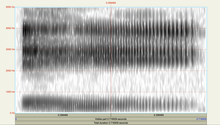
Back Gerundeter halbgeschlossener Vorderzungenvokal ALS صائت أمامي متوسط مغلق مدور Arabic Полузатворена предна закръглена гласна Bulgarian Vogalenn damserr a-raok ront Breton Vocal semitancada anterior arrodonida Catalan Polozavřená přední zaokrouhlená samohláska Czech Gerundeter halbgeschlossener Vorderzungenvokal German Vocal semicerrada anterior redondeada Spanish Voyelle mi-fermée antérieure arrondie French Vokal bulat setengah tertutup depan ID
| Close-mid front rounded vowel | |||
|---|---|---|---|
| ø | |||
| IPA number | 310 | ||
| Audio sample | |||
| Encoding | |||
| Entity (decimal) | ø | ||
| Unicode (hex) | U+00F8 | ||
| X-SAMPA | 2 | ||
| Braille | |||
| |||
| IPA: Vowels | ||||||||||||||||||||||||||||||||
|---|---|---|---|---|---|---|---|---|---|---|---|---|---|---|---|---|---|---|---|---|---|---|---|---|---|---|---|---|---|---|---|---|
| ||||||||||||||||||||||||||||||||
|
Legend: unrounded • rounded |

The close-mid front rounded vowel, or high-mid front rounded vowel,[1] is a type of vowel sound used in some spoken languages.
The symbol in the International Phonetic Alphabet that represents the sound is ⟨ø⟩, a lowercase letter o with a diagonal stroke through it, borrowed from Danish, Norwegian, and Faroese, which sometimes use the letter to represent the sound. This sound is represented by the letter ⟨ø⟩ in most of Scandinavia; by the digraphs ⟨eu⟩ and ⟨œu⟩ (using the ⟨œ⟩ ligature) in French; and by ⟨ö⟩ in many languages like German-derived languages, Estonian, Swedish, Finnish, and Icelandic. The symbol is commonly referred to as "o, slash" in English.
For the close-mid front rounded vowel that is usually transcribed with the symbol ⟨ʏ⟩, see near-close front rounded vowel. If the usual symbol is ⟨ø⟩, the vowel is listed here.
- ^ While the International Phonetic Association prefers the terms "close" and "open" for vowel height, many linguists use "high" and "low".

